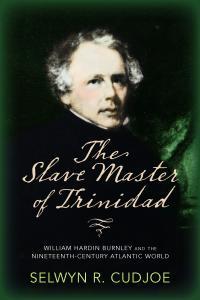Picton's cruelty: Luisa Calderon's resilience
By Dr Selwyn R. Cudjoe
August 08, 2022
There can be no doubt about the cruelty of —Thomas Picton, the first British governor of Trinidad and Tobago (1797-1803), and the resilience of Luisa Calderon, one of the persons he tortured during his governorship.
It is important that we applaud Shabaka Kambon and other patriots who have called for the renaming of streets and monuments that carry his (and other tyrants') names.
As we focus on Picton, we should pay equal attention to Calderon's narrative, the fountainhead of our national beginnings, a point I developed in my book, Beyond Boundaries.
Picton did everything to violate the rights of black and brown people. He feared that the revolution and social conflicts that were taking place in Haiti (1791-1804) and in other parts of the Caribbean would eventually occur in Trinidad. He believed that the black and brown people who had come to Trinidad "hotfoot from the revolutionary orgies of the neighbouring islands", as he described it, were natural troublemakers.
Calderon, a mulatto teenager (we would call her a black teenager today), was shaped by the social and political forces that emerged in early 19th-century Trinidad. Born in Port of Spain in 1786, Calderon was the daughter of Maria del Rosario Calderon, who had immigrated from Cumana, Venezuela, to the island.
In 1801, Calderon was accused of robbing Pedro Ruiz, a white Spaniard with whom she lived in a common law relationship, of $2,000. Ruiz complained to Picton, who immediately committed Calderon to prison with a warning that "if she did not confess who had taken the money, he would order the hangman to put his hand upon her".
Two days later, Picton instructed St Hilaire Begorrat, the head of the prison, to investigate the matter. Begorrat, one of the most influential planters on the island, had played an important role in the trials of slaves who were accused of poisoning others.
Dissatisfied with her answers, Begorrat applied to Picton for permission to torture her, which was granted. One day later, Begorrat tortured Calderon for 54 minutes; and 23 minutes the following day. Still dissatisfied with her answers, he "immediately put her in irons, rather in an erect position, in a garret in the gaol, where she could not stand upright, and continued in this horrid place for eight months".
Pierre McCallum first brought Picton's cruelty to the attention of the British public. He was particularly aggrieved because Vallot, the gaoler, apparently "showed her [Calderon] the treatment which certain Negroes, accused of sorcery, divination, etc, had undergone from a similar punishment".
In 1797, Picton introduced picquetting (later called Picton-ing), a form of British military punishment, to "torture four or five negroes" who, he was convinced, had "held converse with the devil". He also used it to discipline soldiers and to torture enslaved people. One commentator remarked that it "would shock the human mind, to read the black catalogue of crimes which our traveller [McCallum] exhibits against Picton".
In Appeal, John Sanderson noted Picton's horrendous cruelty against the enslaved. He wrote: "Tortures to exhort confession of sorcery, witchcraft, and obeism [Obeahism], public mutilations in the marketplace for such chimerical crimes; and even the burning of the living and dead together in the streets of Trinidad have stained the character of that unfortunate colony with the blood and ashes of the devoted victims of superstitious cruelty, practiced under the authority of ignorant judges."
Calderon's case and Picton's subsequent trial introduced the island's population to the language of colonialism that posited a distinction between them (white and European) and us (black and African).
It also pitted the psychological development of young women in hot, tropical countries against women who lived in cold countries. At Picton's trial in London, William Garrow, who led the prosecution, noted: "At the tender age of ten or eleven, she [Calderon] had been 'seduced' by Pedro Ruiz, 'to live with him as his mistress'."
Garrow explained that although such conduct "may to us in this country appear singular... yet in that hot climate where the puberty of females is much accelerated, it is common for them to become mothers frequently at the age of twelve; at that early period they either marry, or enter into a state of concubinage" (John Epstein, "Politics of Colonial Sensation").
Even as late as 1889, when an ordinance was proposed to lower the age of consent from 16 to 13 years of age, the non-official members of the Trinidad Legislative Council who represented the plantocracy, argued that "girls developed more rapidly in tropical climates and sooner attained the age of puberty".
Calderon was always depicted as a loose woman. This was not unusual. During that period, mulattoes "were often viewed in European travel writing as temptresses, distinguished by their lasciviousness, arrogance and unwillingness to work, and thus threatening to the domestic virtue of British womanhood" (Epstein).
Calderon's narrative shows us how the early Trinbagonian was viewed in the emerging slave society. Embedded in a transcultural setting (she was mulatto of Spanish origins and her grandmother was a slave), Calderon's social position signalled the cosmopolitan nature of the society that would develop as we traversed the 19th and 20th centuries.
As we seek to erase the names of those tyrants who acted so cruelly to our people, we should conduct the necessary research to understand the circumstances that produced them.
As we do so, we should not lose sight of the resilience of people who were forced to withstand such treatment even as they sought to preserve their personhood.
It is a welcome gesture that the Government has named a committee to right the wrongs that started almost 200 years ago. It is an important gesture of national reclamation.
Prof Cudjoe's e-mail address is scudjoe@wellesley.edu. He can be reached @ProfessorCudjoe
Share your views here...

The Slave Master of Trinidad by Dr. Selwyn R. Cudjoe
|

